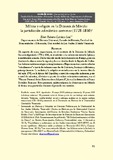Mostrar el registro sencillo del ítem
Milicia y religión en la Diócesis de Mérida: la jurisdicción eclesiástico-castrense (1778-1810)
| dc.rights.license | http://creativecommons.org/licenses/by-nc-sa/3.0/ve/ | es_VE |
| dc.contributor.author | Cardoza Sáez, Ebert | |
| dc.date.accessioned | 2020-05-07T05:19:43Z | |
| dc.date.available | 2020-05-07T05:19:43Z | |
| dc.date.issued | 2020-05-07 | |
| dc.identifier.issn | 1856-9927 | es |
| dc.identifier.uri | http://www.saber.ula.ve/handle/123456789/46750 | |
| dc.description.abstract | Un aspecto de suma importancia, en el contexto de la Diócesis de Mérida durante el período 1778 y 1810, es el relativo a las relaciones entre la Iglesia y la institución armada. Dicho vínculo era de larga duración en Europa, pero en América la alianza entre la espada y la cruz databa desde la llegada de Colón. Las órdenes militares-religiosas trasplantaron a Hispanoamérica ciertos ideales "caballerescos" a través de órdenes como las de Calatrava, Santiago y Alcántara, principalmente. La milicia y la religión se entrelazaron en la tercera década del siglo XVI, en la figura del Capellán, a nivel de compañía miliciana, pero a nivel de ejércitos, el vértice y punto de enlace eclesiástico-castrense, era el "Vicario General de los Ejércitos de su Majestad", lo cual lo detentaba el Sumo Pontífice Romano. Esta presencia militar-religiosa la observamos en Mérida de forma muy particular durante el periodo en cuestión. | es_VE |
| dc.language.iso | es | es_VE |
| dc.publisher | SaberULA | es_VE |
| dc.rights | info:eu-repo/semantics/openAccess | es_VE |
| dc.subject | Milicia | es_VE |
| dc.subject | religión | es_VE |
| dc.subject | capellanía | es_VE |
| dc.subject | Diócesis de Mérida (Venezuela) | es_VE |
| dc.title | Milicia y religión en la Diócesis de Mérida: la jurisdicción eclesiástico-castrense (1778-1810) | es_VE |
| dc.title.alternative | Militia and religion in the Diocese of Mérida: the ecclesiastical-military jurisdiction (1778-1810) | es_VE |
| dc.type | info:eu-repo/semantics/article | es_VE |
| dcterms.dateAccepted | 21-10-2019 | es |
| dcterms.dateSubmitted | 7-7-2019 | es |
| dc.description.abstract1 | A very important aspect, in the context of the Diocese of Merida during the period 1778 and 1810, is the relationship between the Church and the armed institution. This link was long lasting in Europe, but in America the alliance between the sword and the cross dated from the arrival of Columbus. The military-religious orders transplanted to Hispanic America certain ideals "chivalrous" through orders like those of Calatrava, Santiago and Alcántara, mainly. The militia and religion were intertwined in the third decade of the sixteenth century, in the figure of the Chaplain, at the level of militia company, but at the level of armies, the vertex and point of ecclesiastical-military liaison, was the "Vicar General of the Armies of His Majesty", which was held by the Supreme Roman Pontiff. We see this military-religious presence in Mérida in a very particular way during the period in question. | es_VE |
| dc.description.colacion | 93-105 | es_VE |
| dc.description.email | ebertcar4@gmail.com | es_VE |
| dc.description.frecuencia | Anual | es |
| dc.publisher.pais | Venezuela | es_VE |
| dc.subject.centroinvestigacion | Centro de Investigaciones en Ciencias Humanas (HUMANIC) | es |
| dc.subject.centroinvestigacion | Grupo de Investigaciones sobre Historia de las Ideas en América Latina (GRHIAL) | es |
| dc.subject.facultad | Facultad de Humanidades y Educación | es_VE |
| dc.subject.institucion | Universidad de Los Andes | es_VE |
| dc.subject.keywords | Militia | es_VE |
| dc.subject.keywords | religion | es_VE |
| dc.subject.keywords | chaplaincy | es_VE |
| dc.subject.keywords | Diocese of Merida (Venezuela) | es_VE |
| dc.subject.seccion | Anuario GRHIAL: Monográficos | es_VE |
| dc.subject.tipo | Revistas | es_VE |
| dc.type.media | Texto | es_VE |
Ficheros en el ítem
Este ítem aparece en la(s) siguiente(s) colección(ones)
-
Anuario GRHIAL Año 013 - Nº 013
Enero - Diciembre 2019


